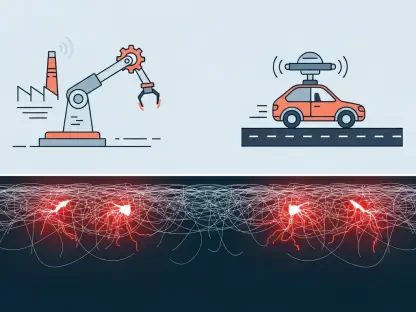In a chilling reminder of the ever-evolving landscape of cybersecurity threats, a sophisticated ransomware campaign has emerged, targeting critical network infrastructure with alarming precision. Reports of the Akira ransomware group exploiting a suspected zero-day vulnerability in SonicWall firewall devices have sent shockwaves through the industry, raising urgent questions about the security of widely used SSL VPNs. This insidious threat, characterized by its ability to bypass even the most robust defenses, has compromised fully patched systems, leaving organizations scrambling for solutions. As attackers leverage obscure weaknesses to deploy ransomware at an unprecedented pace, the global scope of this campaign underscores a broader challenge: how to defend against unknown exploits when traditional measures fall short. The gravity of this situation demands immediate attention, as the potential for widespread disruption looms large over multiple sectors.
Unpacking the Threat Landscape
Emerging Patterns in Ransomware Attacks
The Akira ransomware campaign stands out for its calculated approach, exploiting a potential zero-day flaw in SonicWall SSL VPNs to gain unauthorized access to systems. Unlike typical ransomware operations that rely on phishing or brute force tactics, this group demonstrates a deep understanding of network security architecture. Attackers have been observed bypassing Time-based One-Time Password (TOTP) multi-factor authentication (MFA), a defense mechanism long considered a cornerstone of cybersecurity. Even systems with up-to-date patches have fallen victim, suggesting that the vulnerability lies beyond the reach of standard updates. This alarming trend, intensifying in recent months, highlights the limitations of conventional security protocols when faced with previously unknown exploits. The rapid timeline from initial breach to ransomware deployment—often within hours—further illustrates the efficiency and determination behind these attacks, posing a significant risk to organizations worldwide that rely on SonicWall devices for secure remote access.
A distinguishing feature of this campaign is the attackers’ use of Virtual Private Server (VPS) hosting infrastructure to orchestrate their intrusions. By routing authentication attempts through VPS providers rather than typical broadband networks, the perpetrators maintain a high degree of anonymity, making it challenging to differentiate malicious logins from legitimate ones. Specific Autonomous System Numbers (ASNs) associated with hosting services have been flagged as sources of suspicious activity, pointing to a well-coordinated operation. This tactical shift not only complicates detection efforts but also reflects a broader evolution in ransomware strategies, where adversaries increasingly adopt sophisticated methods to evade traditional monitoring tools. As a result, organizations must rethink their approach to identifying and mitigating threats that originate from unconventional sources, emphasizing the need for advanced behavioral analysis in cybersecurity defenses.
Scale and Impact of the Campaign
The scope of the Akira ransomware attacks extends across diverse industries, with no specific sector or region appearing immune to the threat. Since initial incidents were traced back several months ago, the campaign has escalated, affecting a wide array of organizations that depend on SonicWall firewall devices for network security. The ability of attackers to compromise systems shortly after credential rotations indicates a level of precision that undermines even proactive security measures. Once access is gained through SSL VPNs, ransomware is deployed swiftly, encrypting critical data and disrupting operations with devastating consequences. This global reach underscores the urgency for a coordinated response, as businesses of all sizes grapple with the potential for significant financial and reputational damage caused by these breaches.
Beyond the immediate operational impact, the campaign reveals a critical gap in cybersecurity preparedness. The consistent compromise of updated devices suggests that relying solely on patches and standard authentication protocols is insufficient against zero-day vulnerabilities. Affected organizations face not only the challenge of recovering from attacks but also the daunting task of reassessing their entire security posture. The diversity of targeted systems amplifies the complexity of devising a universal solution, as attackers exploit a flaw that remains largely invisible to current diagnostic tools. This situation serves as a stark reminder of the dynamic nature of cyber threats, where adversaries continuously adapt to exploit the smallest weaknesses, leaving defenders in a perpetual state of catch-up. The broader implications for network security infrastructure call for innovative approaches to threat detection and prevention.
Strategies for Mitigation and Defense
Immediate Actions for Vulnerable Organizations
To address the pressing threat posed by the Akira ransomware group, cybersecurity experts have issued urgent recommendations for organizations using SonicWall SSL VPNs. Temporarily disabling SSL VPN functionality stands as a critical first step until a definitive patch or solution becomes available. This drastic measure, while potentially disruptive to remote access, is deemed necessary given the severity of the vulnerability and the attackers’ ability to bypass existing defenses. Alongside this, implementing comprehensive monitoring through managed detection and response systems can help identify suspicious activity early in the attack cycle. Deploying endpoint detection agents further enhances visibility into potential breaches, providing an additional layer of protection against rapid ransomware deployment. These combined actions aim to minimize exposure while the industry awaits further insights into the nature of the exploited flaw.
Another vital strategy involves blocking VPN authentication attempts originating from identified suspicious ASNs linked to VPS hosting providers. This targeted approach disrupts the attackers’ ability to blend in with legitimate traffic, reducing the likelihood of successful intrusions. Adhering to SonicWall’s security hardening guidelines also offers a framework for bolstering defenses, even if it cannot fully eliminate the risk of a zero-day exploit. Continuous monitoring and real-time threat intelligence sharing are essential to staying ahead of evolving tactics employed by the ransomware group. As investigations into the campaign progress, organizations must remain vigilant, adapting their defenses based on emerging findings. The focus should be on building resilience through layered security measures that account for the possibility of unknown vulnerabilities lurking within critical infrastructure.
Long-Term Considerations for Cybersecurity
Looking beyond immediate responses, the Akira ransomware campaign highlights the need for a fundamental shift in how cybersecurity is approached at an organizational level. Investing in advanced threat hunting capabilities can enable proactive identification of potential exploits before they are weaponized on a large scale. Collaboration across industries to share intelligence on emerging threats and attack patterns is equally crucial, as it fosters a collective defense against sophisticated adversaries. Developing and regularly updating incident response plans tailored to zero-day vulnerabilities ensures that organizations are not caught off guard by similar campaigns in the future. This long-term perspective emphasizes preparedness over reaction, addressing the root causes of systemic weaknesses in network security.
Additionally, the incident underscores the importance of rethinking reliance on specific technologies or vendors for critical security functions. Diversifying infrastructure and adopting a zero-trust architecture can mitigate the impact of a single point of failure, such as the suspected flaw in SonicWall devices. Regular security audits and penetration testing should become standard practice to uncover hidden vulnerabilities before attackers do. As ransomware groups continue to refine their methods, the cybersecurity community must advocate for greater transparency and accountability from technology providers in addressing zero-day threats. Reflecting on this campaign, it becomes clear that only through sustained innovation and cooperation can defenses be fortified against the relentless ingenuity of cyber adversaries.









